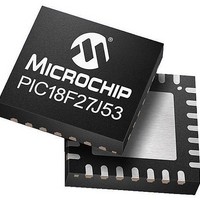PIC16LF1903T-I/MV Microchip Technology, PIC16LF1903T-I/MV Datasheet - Page 99

PIC16LF1903T-I/MV
Manufacturer Part Number
PIC16LF1903T-I/MV
Description
7KB Flash, 256B RAM, LCD, 11x10b ADC, NanoWatt XLP 28 UQFN 4x4x0.5mm T/R
Manufacturer
Microchip Technology
Series
PIC® XLP™ 16Fr
Datasheet
1.PIC16LF1902-EMV.pdf
(240 pages)
Specifications of PIC16LF1903T-I/MV
Processor Series
PIC16LF190x
Core
PIC
Data Bus Width
8 bit
Program Memory Type
Flash
Program Memory Size
4 KB
Data Ram Size
256 B
Maximum Clock Frequency
20 MHz
Number Of Programmable I/os
25
Number Of Timers
2
Operating Supply Voltage
1.8 V to 3.6 V
Maximum Operating Temperature
+ 85 C
Mounting Style
SMD/SMT
Package / Case
QFN-28
Core Processor
PIC
Core Size
8-Bit
Speed
20MHz
Connectivity
-
Peripherals
Brown-out Detect/Reset, LCD, POR, PWM, WDT
Number Of I /o
25
Eeprom Size
-
Ram Size
256 x 8
Voltage - Supply (vcc/vdd)
1.8 V ~ 3.6 V
Data Converters
A/D 11x10b
Oscillator Type
Internal
Operating Temperature
-40°C ~ 85°C
Lead Free Status / Rohs Status
Details
- Current page: 99 of 240
- Download datasheet (3Mb)
11.2
PORTB is an 8-bit wide, bidirectional port. The
corresponding
(Register
corresponding PORTB pin an input (i.e., put the
corresponding output driver in a High-Impedance mode).
Clearing a TRISB bit (= 0) will make the corresponding
PORTB pin an output (i.e., enable the output driver and
put the contents of the output latch on the selected pin).
Example 11-1
Reading the PORTB register
status of the pins, whereas writing to it will write to the
PORT latch. All write operations are read-modify-write
operations. Therefore, a write to a port implies that the
port pins are read, this value is modified and then written
to the PORT data latch (LATB).
The TRISB register
pin output drivers, even when they are being used as
analog inputs. The user should ensure the bits in the
TRISB register are maintained set when using them as
analog inputs. I/O pins configured as analog input always
read ‘0’.
11.2.1
The ANSELB register
configure the Input mode of an I/O pin to analog.
Setting the appropriate ANSELB bit high will cause all
digital reads on the pin to be read as ‘0’ and allow
analog functions on the pin to operate correctly.
The state of the ANSELB bits has no effect on digital out-
put functions. A pin with TRIS clear and ANSELB set will
still operate as a digital output, but the Input mode will be
analog. This can cause unexpected behavior when exe-
cuting read-modify-write instructions on the affected
port.
2011 Microchip Technology Inc.
Note:
PORTB Registers
11-6). Setting a TRISB bit (= 1) will make the
ANSELB REGISTER
The ANSELB bits default to the Analog
mode after Reset. To use any pins as
digital general purpose or peripheral
inputs, the corresponding ANSEL bits
must be initialized to ‘0’ by user software.
shows how to initialize an I/O port.
data
(Register
direction
(Register
11-6) controls the PORTB
(Register
register
11-8) is used to
11-5) reads the
is
TRISB
Preliminary
11.2.2
Each PORTB pin is multiplexed with other functions. The
pins, their combined functions and their output priorities
are shown in
When multiple outputs are enabled, the actual pin
control goes to the peripheral with the highest priority.
Analog input and some digital input functions are not
included in the list below. These input functions can
remain active when the pin is configured as an output.
Certain digital input functions override other port
functions and are included in
TABLE 11-5:
Note 1:
Pin Name
RB0
RB1
RB2
RB3
RB4
RB5
RB6
RB7
Priority listed from highest to lowest.
PORTB FUNCTIONS AND OUTPUT
PRIORITIES
Table
PIC16LF1902/3
PORTB OUTPUT PRIORITY
11-5.
Function Priority
Table
SEG0
AN12
INT
IOC
RB0
SEG24
AN10
VLCD1
IOC
RB1
SEG25
AN8
VLCD2
IOC
RB2
SEG26
AN9
VLCD3
IOC
RB3
COM0
AN11
IOC
RB4
COM1
AN13
IOC
RB5
SEG14
IOC
RB6
SEG13
IOC
RB7
11-5.
DS41455B-page 99
(1)
Related parts for PIC16LF1903T-I/MV
Image
Part Number
Description
Manufacturer
Datasheet
Request
R

Part Number:
Description:
IC, 8BIT MCU, PIC16LF, 32MHZ, QFN-28
Manufacturer:
Microchip Technology
Datasheet:

Part Number:
Description:
IC, 8BIT MCU, PIC16LF, 32MHZ, QFN-28
Manufacturer:
Microchip Technology
Datasheet:

Part Number:
Description:
IC, 8BIT MCU, PIC16LF, 32MHZ, DIP-18
Manufacturer:
Microchip Technology
Datasheet:

Part Number:
Description:
IC, 8BIT MCU, PIC16LF, 20MHZ, TQFP-44
Manufacturer:
Microchip Technology
Datasheet:

Part Number:
Description:
7 KB Flash, 384 Bytes RAM, 32 MHz Int. Osc, 16 I/0, Enhanced Mid Range Core, Nan
Manufacturer:
Microchip Technology

Part Number:
Description:
14KB Flash, 512B RAM, LCD, 11x10b ADC, EUSART, NanoWatt XLP 28 SOIC .300in T/R
Manufacturer:
Microchip Technology
Datasheet:

Part Number:
Description:
14KB Flash, 512B RAM, LCD, 11x10b ADC, EUSART, NanoWatt XLP 28 SSOP .209in T/R
Manufacturer:
Microchip Technology
Datasheet:

Part Number:
Description:
MCU PIC 14KB FLASH XLP 28-SSOP
Manufacturer:
Microchip Technology

Part Number:
Description:
MCU PIC 14KB FLASH XLP 28-SOIC
Manufacturer:
Microchip Technology

Part Number:
Description:
MCU PIC 512B FLASH XLP 28-UQFN
Manufacturer:
Microchip Technology

Part Number:
Description:
MCU PIC 14KB FLASH XLP 28-SPDIP
Manufacturer:
Microchip Technology

Part Number:
Description:
MCU 7KB FLASH 256B RAM 40-UQFN
Manufacturer:
Microchip Technology

Part Number:
Description:
MCU 7KB FLASH 256B RAM 44-TQFP
Manufacturer:
Microchip Technology

Part Number:
Description:
MCU 14KB FLASH 1KB RAM 28-UQFN
Manufacturer:
Microchip Technology

Part Number:
Description:
MCU PIC 14KB FLASH XLP 40-UQFN
Manufacturer:
Microchip Technology










